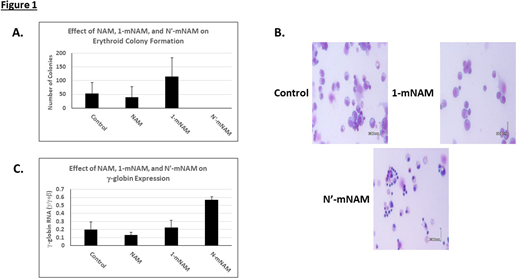Pharmacological treatments designed to increase Fetal Hemoglobin (HbF) levels offer great promise to alleviate the symptoms and improve the lifespan of the vast numbers of patients afflicted with sickle cell disease (SCD) and β-thalassemia. Hydroxyurea can increase HbF, but a large fraction of patients with SCD do not respond to the drug. DNMT1 and LSD1 inhibitors are the most powerful drugs to increase HbF but are limited by side effects that include neutropenia, thrombophilia and/or thrombocytopenia. The development of new, more effective, and safer pharmacological strategies to augment HbF levels in the blood thus continues to be an important goal. Previous studies have shown that γ-globin gene expression is dynamically regulated during erythroid differentiation (Papayannopoulou et al PNAS 74:2923-2927, 1977). The proportion of γ-globin gene expression is higher at earlier stages (BFUe) of erythroid differentiation than at more advanced stages (CFUe). Therefore, we suggest the hypothesis that expansion of primitive, less differentiated progenitors might favor increased γ-globin, particularly when combined other HbF-inducing drugs. To investigate this hypothesis, we have tested whether nicotinamide (NAM), the major NAM metabolite 1-methylnicotinamide (1-mNAM), and N'-methylnicotinamide (N'-mNAM), a chemical derivative of NAM, can foster expansion of erythroid colony-forming cells (BFUe and CFUe) and increase γ-globin expression of cultured baboon CD34+ cells. Previous observations have shown that NAM facilitates in vitro expansion of cord blood CD34+ cells and enhanced long term engraftment in transplanted recipients (Horwitz et al J Clin Invest 124:3121, 2014). Contrasting effects of NAM, 1-mNAM, and N'-mNAM on differentiation and proliferation of the murine erythroleukemia cell line (MEL) have been previously reported (Terada et al PNAS 76:6414, 1979; Kuykendall et al Toxicol In Vitro 21:1656, 2007). While both NAM and N'-mNAM induced MEL cell differentiation, N'-mNAM was far more potent. In contrast, 1-mNAM increased cell proliferation, reduced spontaneous differentiation, and blocked differentiation induced by NAM and N'-mNAM. The effect of all three forms of NAM was examined using bone marrow (BM) CD34+ cells from a pre-clinical non-human primate large animal model. To test the effect of NAM, 1-mNAM, and N'-mNAM on expansion of erythroid colony-forming cells, the agents (5mM) were added to liquid cultures of baboon CD34+ bone marrow cells previously expanded for 5 days in serum-free expansion media (SFEM). Colony assays were performed on d8. In two experiments total erythroid colonies (BFUe and CFUe) were 2 fold higher in cultures treated with 1-mNAM compared to untreated controls (p<0.05) while no effect was observed in cultures treated with NAM. No colonies were observed in cultures treated with N'-mNAM (Figure 1A). Observation of Wright's stained cytospin preparations showed extensive erythroid differentiation on d8 in cells treated with N'-mNAM (Figure 1B). The effect of NAM, 1-mNAM, and N'-NAM on γ-globin expression was tested in baboon CD34+ cells grown in co-culture with the AFT024 cell line. NAM, 1-mNAM, or N'-mNAM (5mM) were added to cultures on d7. Expression of γ- and β-globin mRNA was measured by RT-PCR on d17. Increased γ-globin expression (0.57±0.04 γ/γ+β)) was observed in cells treated with N'-mNAM on d7 compared to untreated controls (0.20±0.09 γ/γ+β; p<0.001). NAM and 1-mNAM had no significant effect on γ-globin gene expression (Figure 1C). These results thus show that while erythroid colonies are increased by 1-mNAM, N'-mNAM is a potent inducer of erythroid differentiation and increases γ-globin expression in primary cultures of baboon CD34+ cells. In conclusion, 1-mNAM and N'-mNAM have contrasting effects on erythroid differentiation in primary baboon CD34+ cell cultures, confirming previous experiments in the MEL cell line. Future experiments are planned to test the effect of these agents on HbF in the baboon.
Saunthararajah:EpiDestiny: Consultancy, Current equity holder in private company, Membership on an entity's Board of Directors or advisory committees, Patents & Royalties.
Author notes
Asterisk with author names denotes non-ASH members.


This feature is available to Subscribers Only
Sign In or Create an Account Close Modal